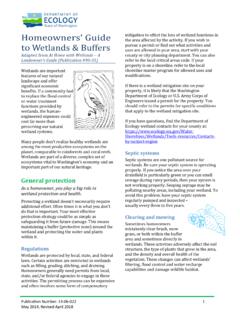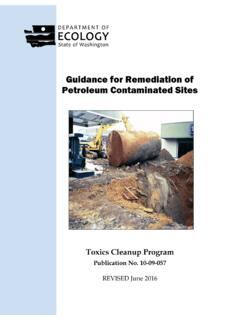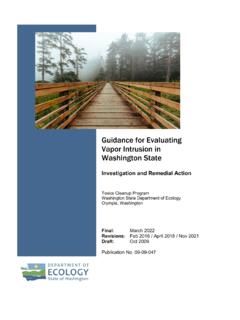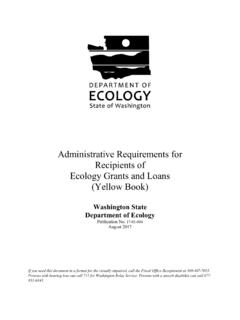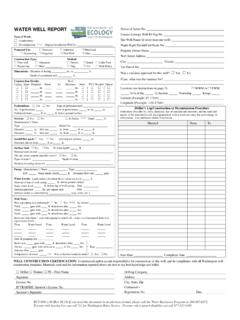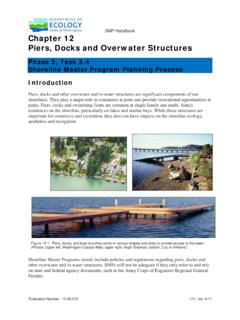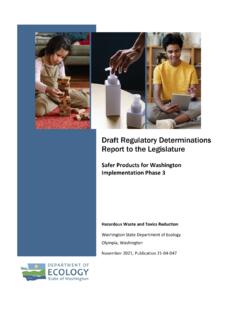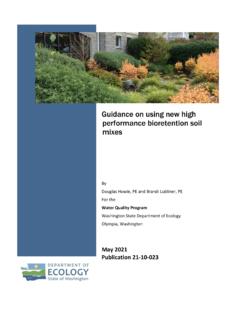Transcription of Pipeline Separation Design & Installation Guidance
1 Pipeline Separation Design and Installation Reference guide Version 9 May 2006 Publication Number 06-10-029 Pipeline Separation Design & Installation Reference guide Version 9 Prepared by: Washington State Water Reuse Workgroup Washington State Department of Ecology Water Quality Program Washington State Department of Health Office of Environmental Health and Safety With Acknowledgment to Primary Authors: Craig L. Riley, WDOH, Water Reclamation & Reuse Program and Michael Wilson, WDOH, Office of Drinking Water July 2006 Publication Number 06-10-029 You can print or download this document from our Web site at: For more information contact: Department of Ecology Water Quality Program Program Development Services Section Box 47600 Olympia, WA 98504-7600 Telephone.
2 360-407-6401 Ada msAsotinBentonChelanClallamCla rkColumbiaCowlitzDouglasFerryFranklinGar fieldGrantGraysHa rborIslandJe ffe rsonKingKitsapKittita sKlickitatLewisicLincolnMasonOkanoganPac ifPendOreillePierceSan JuanSkamaniaSpokaneStevensThurstonSkagit SnohomishWahkiWallaWallaWhatcomWhitmanYa kimaakumNorthwest425-649-7000 Southwest360-407-6300 Eastern509-329-3400 Central509-575-2490 Headquarters (Lacey) 360-407-6000 RegionalOfficelocationSpokaneYakimaLacey BellevuePersons with a hearing loss can call 711 for Washington Relay with a speech disability can call 877-833-6341.
3 If you need this publication in an alternate format, please call the Water Quality Program at 360-407-6401. Persons with hearing loss can call 711 for Washington Relay Service. Persons with a speech disability can call 877-833-6341. Table of Contents EXECUTIVE 1 1 Separation 1 Separation -the Final 2 Special Construction 2 2 3 Need for this 3 3 The Need for Pipeline 4 Importance of adequate 4 Leakage 4 Public Health and Safety 5 Product 6 Maintenance & 7 Pipeline Separation 8 PIPE Separation 9 Elements of Adequate 9 Current 9 Published Separation 9 Horizontal 10 Vertical 11 Current States 11 Engineering and Soils Mechanics 13 Soils Properties Impacts on Critical Trench 14 Parallel Trench Separation vs.
4 Critical Trench 15 MINIMUM PIPE Separation DETERMINATION 18 18 Current 18 Streamlined 18 Sidewall Safety 18 Construction / Repair Work 19 Minimum Trench Sidewall Cover 20 Horizontal 21 Minimum Pipe 21 Design Review 22 Regulatory Approval 22 Recommendations for Alternatives to Standard Separation for Condition 24 Typical Construction Details Condition 24 Case-by-case Approval Requirements Condition 26 Pipeline Separation Design and Installation Reference guide Page iii 26 Approval 26 Approval 26 Suggested 27 Common Utility Corridor Construction- Condition 28 Pipeline Crossing Condition 29 ENGINEERING Design AND LOCATION 30 General 30 Engineering 30 Trench 30 Basic Design 30 Multiple Barriers of 30 Record Information 31 Trigger 31 Design 31 Specific Design 32 Soil Strengths 32 Pipe 33 Conditions Causing 33 Pipeline 34 Mechanics of Pipe Failure Due to 34 Allowable 35 Excavation Site 35 Repair and Replacement 36 37 Table of Figures Figure 1.
5 Pavement damage due to pipe 4 Figure 2: Water line break 5 Figure 3: Sewer 5 Figure 4: Pipeline exposure during 6 Figure 5: Waterline exposed by sewer 7 Figure 6: Collateral utility damage due to sewer 7 Figure 7: Standard horizontal pipe Separation 10 Figure 8: Standard horizontal pipe Separation new construction detail of reclaimed water in developed utility 10 Figure 9: Standard pipe crossing new construction detail - vertical 11 Figures 10 and 11: Mechanism for parallel trench 13 Figure 12: Critical trench depth based on soils 15 Page iv Pipeline Separation Design and Installation Reference guide Figure 13: Parallel pipe excavation 15 Figure 15: Causes of cave-ins (trench surcharges) from Saskatchewan Labour 20 Figure 16: Pipe Separation assessment decision 23 Figure 17: Typical benched - common trench construction 25 Figure 18: Typical pipe crossing construction detail Condition B 25 Figure 19: Condition C utility 27 Figure 20: Common underground utility 28 Figure 21.
6 Condition C -vertical pipe 29 Figure 22. Lincoln and Spokane county soil 33 Figure 24: Sand boils resulting from joint 34 Figure 25: Typical trench surcharge 36 Figure 26: Field conditions - typical trench 36 List of Tables Table 1: Utility Separation regulations and standards from various 12 Table 2: Soil Strength 14 Table 3: Estimates of horizontal pipe Separation vs. critical trench depth for water line buried at 16 Table 4: Estimates of horizontal pipe Separation vs. critical trench depth for sanitary sewer line buried at 16 Table 5: Trench sidewall cover 21 Table 6: Conditions for Separation in Design with space 22 Table 7.
7 An Example of soils information from the NRCS Web 32 Table 8. Allowable leakage based on standard 35 Pipeline Separation Design and Installation Reference guide Page v Page vi Pipeline Separation Design and Installation Reference guide Executive Summary Introduction As water reclamation and recycling assumes a larger and more important role in the management of water resources, challenges in designing and locating piping systems for the distribution of reclaimed water are daunting. Existing standards require horizontal and vertical separations between potable water, reclaimed water, storm water and sanitary sewage that are rarely available in developed urban areas.
8 While special construction practices are allowed to overcome these obstacles, regulatory approval is required on a case-by-case basis. This process is cumbersome, and increases Design and construction costs, as well as the completion schedules. The Washington State Department of Ecology and the Department of Health developed this Guidance in response to the need for a streamlined process and to assist utility engineers with Pipeline Separation Design and Installation . Pipeline Separation is a necessity for protection of public health and safety, property and the quality of the Pipeline contents.
9 Pipeline failure or leaks can result in Pipeline contamination that increases risks public health and safety. Pipelines do not have to rupture completely or collapse to cause concern. Even the process of excavating one Pipeline to repair a leak creates the risk of complete failure of adjacent pipelines. Separation Standards The current Pipeline Separation standards are based on accumulated field and Design experience, and the Ten State These standards generally require a minimum horizontal Separation of 10 feet between parallel pipes, and 18 inches of vertical Separation .
10 Many states have adopted these standards as Guidance or regulation. In 1968, engineers at Utah State University investigated the effects of trench excavation on Separation distances from a buried parallel pipe. Their work resulted in a relationship between the distance from the trench face to the parallel pipe [sidewall thickness, X] necessary to prevent trench wall failure, the critical trench depth [Z], which depends on soil strength characteristics; the depth of bury [H] of the parallel pipe; and size of the parallel pipe [D]: ZHDX =3 An analysis using this relationship shows that, in some instances, distances less than the standard horizontal Separation distance can be justified.
